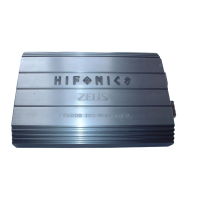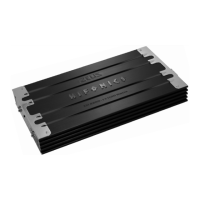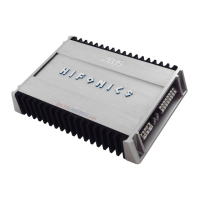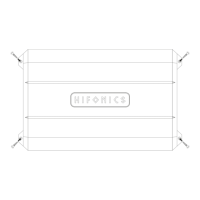
Do you have a question about the Hifonics Zeus ZX4000 and is the answer not in the manual?
| Channels | 4 |
|---|---|
| Signal-to-Noise Ratio | > 100 dB |
| Damping Factor | > 200 |
| Crossover Frequency | 50 Hz - 250 Hz |
| Phase Shift | 0° - 180° |
| Efficiency | > 85% |
| RMS Power at 4 Ohms | 1000W |
| RMS Power at 2 Ohms | 2000W |
| Total RMS Power Output | 4000W |
| Frequency Response | 10 Hz - 20 kHz |
| THD at Rated RMS Power | <0.05% |
| THD | <1% |
| Input Sensitivity | 200 mV - 6 V |
| Bass Boost | 0dB - 18dB |
| Subsonic Filter | 10Hz - 50Hz |
| Operating Voltage | 10V - 16V |
Overview of the Zeus Series amplifiers, covering their general capabilities and features.
Detailed feature descriptions for the 2-channel Zeus amplifiers.
Detailed feature descriptions for the 4-channel Zeus amplifiers.
Detailed feature descriptions for the 5-channel Zeus amplifier.
Describes the basic application for Zeus Series 2-channel amplifiers in a full range stereo setup.
Illustrates the basic mono bridging method for all HiFonics amplifiers.
Details a 2-way active or bi-amplified system using a 2-channel amplifier for highs and lows.
Shows how to use 4-channel amplifiers as discrete 4-channel full range units.
Demonstrates using 4-channel amplifiers for 2 or 3 channel systems via mono bridging.
Explains implementing a 2-way active system with mono bass using a 4-channel amplifier.
A variation for 2-way systems using front/rear outputs for fade control of highs and bass.
Combines a 2 and 4-channel amplifier for front/rear highs and mono sub bass.
Configuration for 4 discrete full range channels with a 5th low pass channel.
Setup for a 3 or 4 channel arrangement with mono bridging and a low pass channel.
Utilizes the ZX8000 for a self-contained 3-way active crossover system with mono bass.
Applies 4 channels for front/rear satellites and the mono channel for constant sub bass.
Factors influencing the success of a car stereo system, including design and component choice.
Basic guidelines for mounting amplifiers and running wiring to avoid noise and damage.
Essential steps for proper power and ground connections, including wire gauge and terminal integrity.
Recommended order for connecting speaker wires, RCA cables, and power for safe operation.
Procedure for safely powering up the installed system to check for faults.
Initial steps for setting up after installation, with controls at minimum.
Procedure for matching amplifier input sensitivities to the head unit output signal level.
Level control adjustments for single 2-channel and 4-channel systems, and 2/3-way active systems.
Adjusting crossover frequencies for optimal sound quality and protection.
Fine-tuning the system's frequency response using equalizers and tone controls.
Explanation of the built-in diagnostic system that indicates faults via the PROTECT LED.
Causes and solutions for amplifier shutdown due to heatsink overheating.
Troubleshooting steps for low output power, including level controls and voltage checks.
Reasons for fuses blowing, such as impedance issues or short circuits.
Steps to diagnose why the system fails to power on, checking fuses and connections.
Diagnosing and resolving noise issues like hiss, white noise, and electrical interference.










